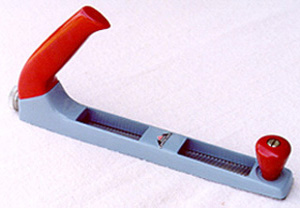No. 1220 Plane-’R-File
 Not a bench plane by any stretch of the imagination, the No. 1220 Plane-’R-File is included in the bench planes section of this site because of the similarity of its form to that of a common hand plane. A surform tool introduced by the Millers Falls Company in 1957, the Plane-’R-File was taken out of production and removed from the firm’s price lists in mid-1966. With its gray die cast body, red tenite knob and stylized reversible handle, the No. 1220 ranks as one of the most visually interesting of the company’s tool designs. The Plane-’R-File was developed by noted industrial designer L. Garth Huxtable
and is considered such an outstanding piece of work that an example has been included in the collections of the Museum of Modern Art.
Not a bench plane by any stretch of the imagination, the No. 1220 Plane-’R-File is included in the bench planes section of this site because of the similarity of its form to that of a common hand plane. A surform tool introduced by the Millers Falls Company in 1957, the Plane-’R-File was taken out of production and removed from the firm’s price lists in mid-1966. With its gray die cast body, red tenite knob and stylized reversible handle, the No. 1220 ranks as one of the most visually interesting of the company’s tool designs. The Plane-’R-File was developed by noted industrial designer L. Garth Huxtable
and is considered such an outstanding piece of work that an example has been included in the collections of the Museum of Modern Art.
The tool’s replaceable blades were manufactured by the Tresa File Company of England and could be flipped over to provide a new cutting surface as they dulled. Standard blades were available in coarse and medium cuts. Tungsten carbide blades in fine, medium and coarse grades were also available. Advertised as capable of planing, filing, shaping and smoothing woods, plastics and metals, the No. 1220 suffered from the problem common to most multi-use tools—its suitability for any one job was compromised by its versatility. That said, the purchase of a Plane-’R-File added a good deal of functionality to a home tool box at a moderate price. Unlike conventional rasps, the availability of replacement blades ensured its continuing utility after its cutting edges became dull.
Packaging
 The company pulled out all the stops in coming up with the box design for the Model 1220 Plane-’R-File. At the time, the standard container for Millers Falls tools consisted of a plain chipboard box with a red-colored lid. A pastel green label was pasted to one end, and most labels consisted of little more than a model number, the company address and logo and a minimal description of the tool.
The company pulled out all the stops in coming up with the box design for the Model 1220 Plane-’R-File. At the time, the standard container for Millers Falls tools consisted of a plain chipboard box with a red-colored lid. A pastel green label was pasted to one end, and most labels consisted of little more than a model number, the company address and logo and a minimal description of the tool.
The design of the box indicates that the company believed hardware dealers would prefer to sell the Plane-’R-File in its container, rather than displaying it on open shelves as was customary with hand planes. The attention given the packaging also reflects a concern that potential customers wouldn’t quite know what to make of the new tool. The front side of the box not only states that the tool can be used as both plane and file, illustrations showing the handle positions reinforce the idea. The back side includes detailed instructions for the use of the tool as does an accompanying paper insert.
It may be putting too fine a point on it, but one has to wonder if those responsible for the Plane-’R-File’s promotional slogan were subliminally influenced by the Superman television series so popular at the time...
- The series promotion:
- “It’s a bird! It’s a plane! It’s SUPERMAN”
- The box:
- “It’s a plane! It’s a file! PLANE-’R-FILE”
This “catchy” phrase also served as catalog copy. As flat as the slogan and convoluted name of the Plane-’R-File sound today, they were typical of their time. The colorful packaging in which the first Plane-’R-Files were shipped eventually gave way to standard issue boxes. The colorful boxes were expensive, and as the public became more aware of surform tools, increasingly unnecessary.